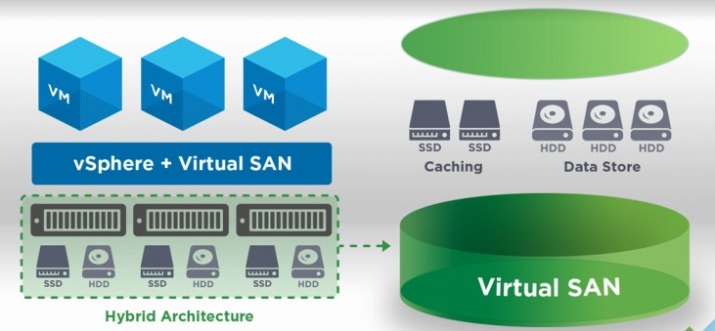![]()
There can be data center intelligent and automated without a storage that is equally. In other words, the approach Software-Defined which in recent years has reached the servers and network components must be extended to data storage. This vision VMware , inaugurated with the vSphere platform, and since last year also extended to storage with Virtual SAN, an offer that now with version 6 can boast double scalability and improved performance of more than four times and a half than the previous. A VSAN 6 (so named for consistency with the numbering reached by vSphere) joins a further solution for storage management, vSphere Virtual Volumes, able to make the array of third party “virtualization-aware” natively.
The use of a single point of access to perform provisioning and resource management and policy-based automation represent two of the most obvious advantages of the approach defined by the software. By averaging between the different cost items related to storage (deployment, configuration, reconfiguration, management, and more) analyst firm Taneja Group has calculated that with VSANs can cut by 66 % operating expenses .
The promises of the Software-Defined or simplification, scalability and cost cutting, can not be realized without including storage in the virtuous circle. Also because the storage of data is one of the most expensive components in the data center and – first of virtualization – seemed destined to accentuate this trend to deal with the explosion of content generated by social, from the cabinet and by the Internet of Things. We discussed it with Alberto Bullani, regional manager of VMware Italy , and Luca Zerminiani, pre-sales manager.

Alberto Bullani, regional manager of VMware Italy
As you insert the Software-Defined Storage within the path of evolution of the data center?
Bullani : It is a fundamental step. We firmly believe that the software component is essential in our offer as much in general for the Software-Defined Data Center. In the world, the need for fully automated centers is growing, and within this need efficient and intelligent storage plays an increasingly important role. Just think of the explosion of data generated by social and from the mobile.
And the strategy of VMware?
Bullani : Storage is the last component that was added to complete our proposal. We started with virtualization of computational part and then, following the acquisition of Nicira realized in 2012, we extended the offer software-defined networking. Last year the launch of VSANs marked the debut of the Software-Defined Storage VMware. It was, however, a beginning almost unnoticed, mind now with the new version, VSAN 6, we have a platform ready for production environments and mission-critical, that is functionally much more extensive.
Last year VMware billed globally about five billion dollars. Our goal is to ensure that within a few years the offer of Software-Defined Storage contributes to the turnover in the amount of one billion dollars.
Where are we, in Italy with the adoption of this approach?
Bullani: The presence of many small and medium enterprises is accelerating this process. A solution such as VSANs allows a management software storage even in small data centers at low cost, avoiding companies to have to buy a Storage Area Network which also would be used for a single purpose. Instead, take the San within the virtualized infrastructure is an easier way, flexible and quick to reshape a data center, however small.
In any case, today, in Italy, there is interest in this issue, although still not observe mass deployment. Our customers more ready and “visionary”, as had happened with the virtualization of the network, were the first to adopt VSANs. Overcome psychological barriers, we believe that this year will witness the true large-scale adoption.

Luke Zerminiani, pre-sales manager
How did VSAN?
Zerminiani: While on the VMware server had already done a big job virtualization, until recently, the components of the networking and storage had not followed the same trend. And thus hindered quell’agilità instead had been introduced in the data center with server virtualization. From here came the idea of going to lighten those parts that were still “heavy”, and do follow the model of the hybrid cloud, the result more suited to meet the needs of companies. But the ability to mix and external environments on premise posed a technological hurdle: while you can move a virtual machine from one infrastructure to another, the same thing is not as easy with SAN storage resources, which need to be configured. The problem was overcome with VSAN doing storage become a property of the virtual machine: in this way, every time the virtual machine “lands” on external infrastructure, it is able to carve out all the storage resources that are used .
What are the main benefits?
Zerminiani : VSAN is a storage component that generates a San starting from internal hard drives to the server. In fact, it is a creation software. It is a cost-effective solution and low cost of entry: one of its benefits is being able to exploit the internal disks, often unused servers on a virtualization infrastructure. It does not require, as for the physical storage resources, a margin of “abundance” due to the difficulty of predicting future needs.
It also has the advantages of performance and scalability because, compared to what is outside an appliance, not support for infrastructure but it is a component. VSAN does not create an artifice of storage, but it is already encoded within the vSphere platform.
The third aspect to note is that VSAN 6 is production-ready. From the first version, presented last year, we have made considerable progress on the three key aspects of software that aims to go into production: the ability to scale, performance and availability, ie high reliability. Among other innovations, now you can also opt for configurations totally based on flash technology.

To whom you speak?
Zerminiani : The offer VSAN has definitely targeting small and medium enterprises, is located in an area of storage medium level, while our vision for the enterprise is completed by vSphere Virtual Volumes, which implements the same concepts but on resources external storage and high-end performance. What does not change is the approach to Software-Defined, that is our business model: a storage integrated with virtual infrastructure, and that can grow and scale with it.
No comments:
Post a Comment